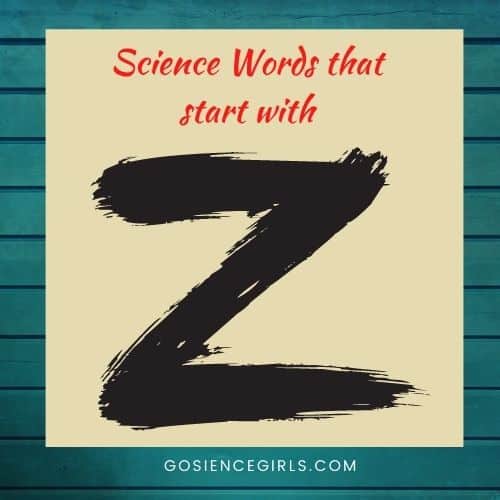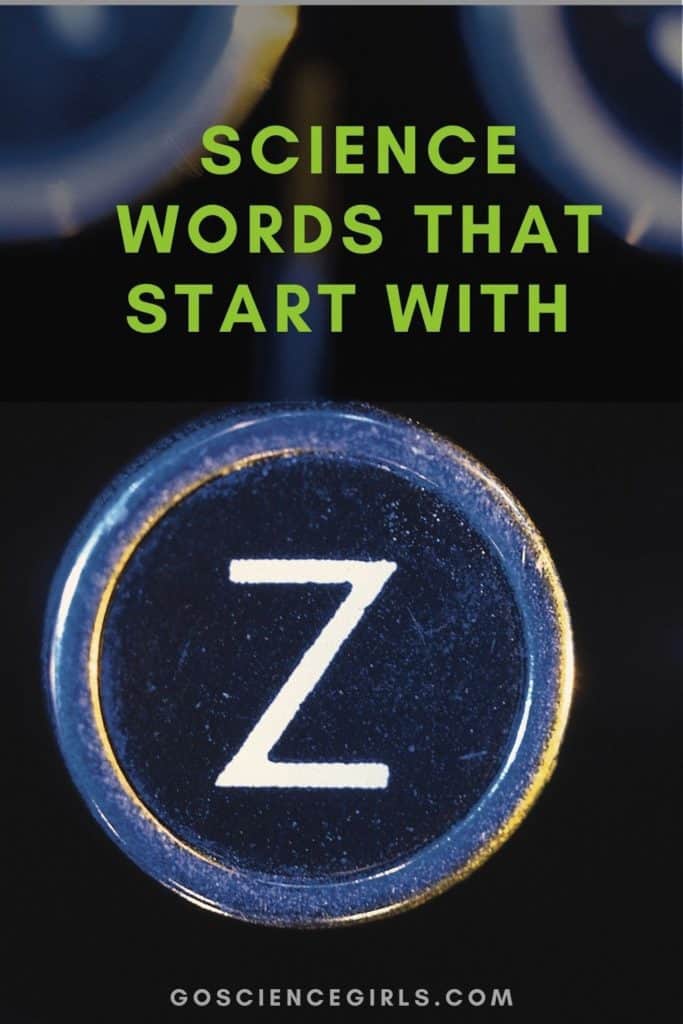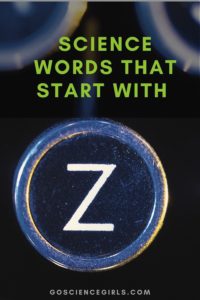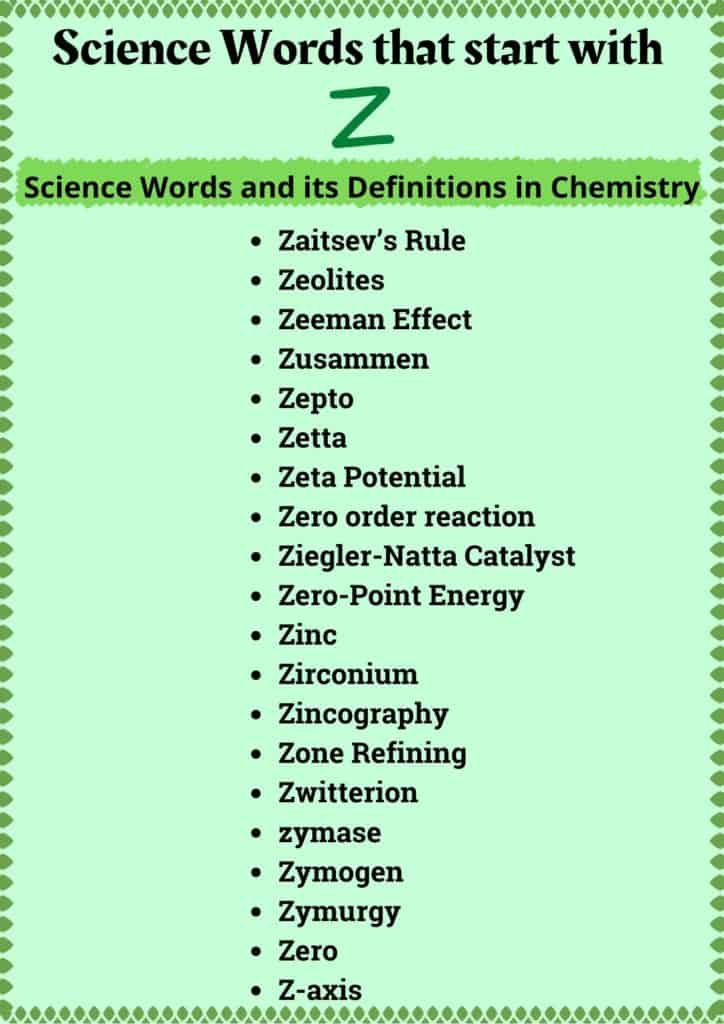In this post, I have compiled a great list of science words that start with the alphabet ‘Z.’ I am excited to share these words with you and continue reading this post if you are also interested.
Glossary of Science Words that start with Letter’ Z.’
In this post we will cover:
- Chemistry Words That Start with Z
- Biology Words That Start with Z
- Glossary of Inventor Names That start with Z

Science Words and its Definitions in Chemistry
Zaitsev’s Rule: Zaitsev’s rule refers to the empirical rule that predicts the highly substituted alkene compound is removed from a chemical and elimination reaction. It is a significant rule in all elimination reactions in organic chemistry.
For Example, The highly substituted compound in the reaction between 2-iodobutane and alcoholic potassium hydroxide (KOH) is 2-butene. Here, 2-butene is the most stable and favored compound eliminating in the reaction.
Zeolites: Zeolites are the microporous crystalline rock-hard materials that come with a framework of hollow cavities. These complex substances encompassed aluminium, oxygen, and silicon, allowing water and other small molecules to fit in hollow channels. And the hollow cavities and canals refer to molecular sieves.
In chemistry, zeolites help separate molecules and work as a trap to hold specific molecules. Besides, zeolites come in use for purifying and softening the water through the ion-exchange method.
Zeeman Effect: In physics and astronomy, Zeeman Effect is the effect that explains the splitting of spectral lines using static magnetic fields into at least one or more than two components. And these components vary slightly in frequencies while the light source comes in contact with a magnetic field. However, this effect resembles the Stark Effect, which also explains the spectral line is splitting but in the electric field.
Z (Zusammen): Z denotes substituent groups’ arrangement from higher to lower places according to their stereochemical arrangements. These stereochemical arrangements are mostly happening in alkene double bonds.
Zepto: Zepto refers to the unit in metric system used as a prefix for substances associated with x10-21, i.e., 0.000000000000000000001. As it is equal to 1000⁻⁷, it came from the Latin word ‘Septem,’ which means seven. For Ex: The electric charge on one electron: 160.217657 zepto-coulombs.
Zetta: Zetta is again another unit prefix in the metric system, but it denotes the decimal units and adds as a prefix for substances with x1021. Z represents the unit prefix Zetta.
Zeta Potential (ζ-potential): The scientific term used for abbreviating electro-kinetic potential in the colloidal systems at the slipping planes is zeta potential. To put it simple, the possible dissimilarity between two different states of matter, i.e., solids and liquids across their boundaries, is zeta potential.
For suppose, if a colloidal substance is more stable means, it consists of higher zeta potential. While a zeta potential value is zero, then the colloidal substance remains a residue in solid form.
Zero Order Reaction: The reactions whose reaction rate does not depend on reactants’ concentration are zero-order reactions.
For Ex: The photochemical reaction between chlorine and hydrogen, Decomposition of NH3 in the presence of molybdenum or tungsten, Iodization of acetone in H+ ions are a few best examples of zero-order reactions.
Ziegler-Natta Catalyst: Ziegler-Natta catalyst, the catalyst named after Karl Ziegler and Giulio Natta, and is useful for the synthesis of α-olefin polymers and 1-alkene. Primarily, the polymers synthesized through this catalyst constitute highly molecular weights and stereo-regular structures. For Ex: TiCl4+Et3Al and TiCl3+AlEt2Cl, the chemical formula includes TiCl4-Al(CH3)2(CH2)2Cl.
Zero-Point Energy: Zero-point energy, also known as a ground state, represents the level possessing the lowest potential energy in a quantum mechanics system.
Zinc: In chemistry, zinc is a brittle chemical element that appears bluish and silvery in color with atomic number 30 and symbol ‘Zn.’ In the human body, zinc is the second most significant mineral that is useful in many ways to perform bodily functions. It also plays a vital role in performing many functions of the human body, such as nerve function, digestion, metabolism, etc. On the other hand, it also helps the human body’s immune system invade viruses and bacteria.
Zirconium: Zirconium, a strong transition metal cum chemical element holding the atomic number 40 and symbol ‘Zr.’ By appearance, it is silverfish grey and malleable, strong, and ductile by nature. And hence, it is highly resistant to corrosion and used in corrosive environments.
Zincography: The planographic or lithographic process of attaining zinc plates to produce a printing surface using a strong acid is called zincography.
Zone Refining: The chemical processing of purifying crystalline substances like metals and other semi-conductors is zone refining. This process happens by creating a narrow molten zone to make impurities concentrated and travel alongside. Floating zone process, zone melting, and travelling melting zone are other names for zone refining.
Zwitterion: Any chemical molecule or ion which consists of an isolated and equal number of positive and negative charged functional groups is a zwitterion. Amino acids are the best examples of zwitterions with functional groups, amines, and a group of carboxyls.
Zymase: The enzyme which catalyzes the fermentation reaction in alcohols to breakdown certain sugars is zymase. It is a combination of enzymes resulting from the fermentation of yeast. For Ex: breaking sugars into ethanol and carbon dioxide. Though it occurs in all kinds of the yeast strain, the reaction varies from one strain to another. The name zymase also refers to the drug pancrelipase.
Zymogen: Inactive protein, also called a proenzyme, undergoes biochemical reactions to synthesize enzymes along with an organism is zymogen. This biochemical process generally happens in Golgi bodies, where the isolated enzyme is divided into specific parts to activate the inactive proteins. For Ex: Pepsinogen is the precursor of pepsin.
Zymurgy: The scientific research and study on fermentation (biochemical process) happening especially while brewing, distilling, and winemaking is Zymurgy. The scientist who works on conducting the research studies on the fermentation process while brewing and winemaking is a zymurgist. And zymology is the branch of applied science that tells about the biochemical process of fermentation and its uses in brewing and distilling is zymology.
Zero: Zero is simply a number that represents neutral value in mathematics and helps us understand the integers, algebraic structures, and real numbers. When zero is placed on the left side of a number, it does not add any value to that, but it adds value to that number when placed on the right side of a number.
Z-Axis: Z-Axis is the third co-ordinate axis in a three-dimensional space and is generally oriented vertically.
Glossary of Science Words in Biology
Zollinger-Ellison Syndrome: Zollinger-Ellison syndrome is a kind of medical condition in which tumors in the stomach activates the production of acids in extra amounts. This production of acids in quantities excess results in the formation of peptic ulcers. And the neuroendocrine tumor gastrinoma is the primary culprit to cause this disease. However, the symptoms of this disease include diarrhea and abdominal pain.
Zygomatic Arch: The bone which connects the temporal bone of the midface, extending from lateral sides of the skull over the ear opening, and the side portion of the cheekbone is the zygomatic arch. The zygomatic arch’s primary function is to protect the face’s eye portion as it is susceptible and soft with soft bones.
Zygote: Zygote is nothing but a fertilized egg formed from the fertilization process of two gametes, i.e., male and female. During the initial days, the zygote is a eukaryotic cell that starts with a single cell, but it develops into a multi-cell structure during later stages. Eventually, the zygote develops into an embryo because it consists of genetic information from two gametes and can develop into a new individual.
Zoology: In biology, the study of animal life and its characteristics like evolution, habits, classification, embryology, structure, shapes, and size is zoology. Also, this study helps in studying the extinct and endangered animals and how they interact with current ecosystems.
A zoologist is the person who studies the kingdom of animals and their life under scientific methods.
Zone: A zone is a specific area that separates it from another area and consists of a living system species, either it is a plant or animal kingdom. However, some changes happen in zones only when there are environmental changes.
Zero-impact: When there is no impact of environmental changes over current situations and living habitats of living organisms, that situation refers to zero-impact.
Z-DNA: DNA in living organisms comes in many possible ways in double-helical structures and hence divides the parent sequence into many types of DNA. Among them, Z-DNA is one type of DNA with left-handed double-helical structures. This means the helix takes a turn on the left-handed side and shows a different pattern because of an alternate pattern of bases in syn and anti-conformation.
Zebra-Fish: Zebra-Fish, originated from South Asia and belonged to the family Cyprinidae or Minnow. It is a famous aquarium fish useful for scientific research to understand various higher class organisms’ biological functioning. Because of easy maintenance, rapid embryonic development, transparent embryo, it became a perfect scientific research model.
Zodiac: The specific imaginary belt area that extends its stretch 8 degrees towards either side of the elliptical is the zodiac. This area includes all the other apparent areas of the Sun, Moon, and other planets. And the term derived from the Latin word Zodiacus which means circle of animals. However, this longitude divides the elliptic into 12 constellations, which are very much valuable for astrology. The 12 signs include; Aries, Taurus, Gemini, Cancer, Leo, Virgo, Libra, Scorpio, Sagittarius, Capricorn, Aquarius, Pisces.
Zooplankton: Zooplankton, the term derived from Greek zoon, which says, animal drifting. The plankton consisting of different types of small and immature stages of animals is zooplankton. As it consists of other animals, it is heterotrophic plankton and ranges from microscopic to more giant animals.
Zooxanthella: A single-celled symbiotic dinoflagellate exists in huge groups in the cytoplasm of diverse marine invertebrates, which include corals, jellyfishes, demosponges, etc. is zooxanthella. Symbiodinium is the other name for zooxanthella.
Zinc Fingers: A finger-like loop of tiny protein structures that combines more than two zinc ions to stabilize DNA structure is a zinc finger. Usually, zinc fingers bind to the helix of DNA through larger grooves and even undergo homo-dimerization to reinforce the strong bonding.
Zona Pellucida: The crystal clear membrane present on the ovum before implantation is zona pellucida. This layer helps in supporting the way of communication between follicle cells and oocytes during oogenesis. Thus, it protects the eggs, sperms, oocytes, and embryos during fertilization.
Zona Reaction: The biochemical reaction which makes zona pellucida alter its solubility and binding properties in mammals is the zona reaction.
Zoo: The place where there is a vast collection of different types of animals ranging from more minor to larger species either for research purposes or for public display is a zoo. Mostly, the establishment of this place of living things happens around the parks and gardens.
Zoo Sexuality: The sexual positioning through which a human attracts sexually towards animals is zoo sexuality.
Zygonema: The zygotene stage of prophase I of meiosis is zygonema. Through which one can observe the synapsis process of homologous chromosomes begins.
Zygotene: Zygotene is the second stage of prophase 1 of meiosis, resulting in the formation of bivalents through synapsis.
Zygotic Induction: The process of transporting viral DNA from a silenced bacterial DNA into another bacterial cell that does not have viral DNA is zygotic induction. This process happens by breaking the recipient bacterial cell’s DNA open to receive the new viral DNA.
Zygotic Selection: The technique of causing differential mortality in an organism through specific forces and at any stage of its life cycle except gametes is zygotic selection.
Zymometer: The scientific instrument which helps determine the rate of fermentation is the zymometer.
Zymosimeter: Zymosimeter is another scientific device helpful in measuring the speed of fermentation in yeast. Zymoscope is another name for this instrument.

Glossary of Inventors on Letter Z
Al-Zahrawi: Al-Zahrawi was a prominent inventor of medieval surgical and medical instruments. And he also showed his efforts in recognizing and describing the characteristics of the disease hemophilia. The other inventions of Al-Zahrawi include: stating about abdominal pregnancy, ectopic pregnancy, finding our root cause of paralysis, and developed surgical devices for Caesarean sections and cataract surgeries. (Source)
Frank Zamboni: Frank Zamboni was a famous engineer and inventor from America and known for the ice resurfacer’s invention. A few of his honorable awards include Honorary Doctorate of Engineering from Clarkson University and NEISMA Hall of Fame in 1988, United States Figure Skating Hall of Fame in 2000, the World Figure Skating Hall of Fame in 2006, the National Inventors Hall of Fame in 2007, U.S. Hockey Hall of Fame in 2009 and United States Speed Skating Hall of Fame in 2013. (Source)
Giuseppe Zamboni: Zamboni was a great inventor and physicist who invented the Zamboni pile. Zamboni pile is nothing but an earlier time electric battery, which resembles a voltaic pile. Also, he was very well famous for developing an advanced version of an electric battery, i.e., dry pile. The dry pile is the electric battery which works without electrolyte.
L. L. Zamenhof: Zamenhof, the Polish inventor who became famous for developing the international auxiliary language globally, Esperanto. He was not only an inventor but also a renowned linguist and ophthalmologist. And his fantastic language invention helped the world to communicate fairly and equitably. For his achievements and efforts, UNESCO selected him as the eminent personality of 2017.
Walter Zapp: Walter Zapp, the creator of Minox Subminiature Camera, was a Baltic German inventor. And for his efforts to the Republic of Estonia, he received an honorary doctorate of the Latvian Academy of Sciences. Besides, he also received a Europa postage stamp in 1994 for inventing the subminiature camera.
Abū Isḥāq Ibrāhīm al-Zarqālī: Abū Isḥāq Ibrāhīm al-Zarqālī, an Arab muslim astronomer from Islamic world. He was also famous as an astrologer and instrument maker and inspired many generations of Islamic astronomers. The best honor he received is the crater, Azrachel, named after his death.
Yevgeny Zavoisky: Yevgeny Konstantinovich Zavoisky, the full name of Zavoisky, was a soviet physicist from Russia. He became very famous for his efforts in inventing electron paramagnetic resonance in 1944. His other fascinating inventions include designing the luminescence camera to detect nuclear processes and magneto-acoustic resonance in plasma.
Stalin Prize, Lenin Prize, and International EPR Society Award are the honorable awards he received for his electron paramagnetic resonance talent.
Nikolay Zelinsky: Zelinsky, a soviet chemist, served as a member of the USSR Academy of Sciences from Russia. Zelinsky invented the primary and effective activated charcoal gas mask. Also, he worked hard to develop the theory of organic catalysis along with other founders. He received Lenin Order in the years 1940, 1945, and 1946 plus Stalin Prize in the years 1942, 1946, and 1948.
Ferdinand von Zeppelin: Zeppelin, the inventor of Zeppelin rigid airships and was the native of Germany.
Frits Zernike: Zernike became popular by receiving Nobel Prize in Physics for his talent in inventing the phase-contrast microscope. He was the native of the Netherlands, and his best inventions include Zernike polynomials, Ornstein–Zernike equation, and Van Cittert–Zernike theorem. He received the Rumford Medal, Fellow of the Royal Society, and Nobel Prize in Physics.
Tang Zhongming: Tang Zhongming, a Chinese engineer and inventor, developed an internal combustion engine motorized by charcoal.
Jian Zhou: Jian Zhou, a Chinese virologist and cancer researcher became famous for inventing vaccines for stimulating immunological resistance. Those vaccines include Gardasil and Cervarix, which play a significant role in preventing the impact of the cervical cancer-inducing human papillomavirus.
Nikolay Zhukovsky: Zhukovsky, the father of modern aero- and hydrodynamics, was a Russian engineer, mathematician, and scientist. He was also famous as ‘Father of Russian Aviation and fluid dynamics. Order of Saint Anna, Order of Saint Stanislaus, and Order of Saint Vladimir was the prestigious awards received by Zhukovsky.
Karl Ziegler: Ziegler was a famous chemist who received the Nobel Prize for developing polymers in chemistry. Many-membered rings, free radicals, organometallic compounds, and Ziegler-Natta catalyst are other concepts he worked on and received prestigious honors. The Werner von Siemens Ring was one of Ziegler’s many awards for developing the idea of synthesizing new materials.
Franz Ziehl: Franz Ziehl, German Bacteriologist invented the new strain of tubercle bacillus i.e. the carbol fuchsin stain. Also, along with another pathologist, Friedrich Neelsen, he introduced a new strain used to recognize acid-fast bacteria, i.e., Ziehl–Neelsen stain.
Konrad Zuse: Zuse was a famous scientist in computers and civil engineer from Germany. He became famous by inventing the modern computer. The world’s the first programmable computer. Also, he developed a high-level programming language, Plankalkul, and other electro-mechanical computers, i.e., Z3 and Z4. Calculating Space was also a remarkable achievement in his career.
Vladimir K. Zworykin: Vladimir K. Zworykin, a Russian-American inventor, introduced new technology to run televisions. His television technology includes a transmitting and receiving system to employ cathode ray tubes, infrared image tubes, and electron microscopes. Well, his other significant works include designing Iconoscope, Photomultiplier, kinescope, and other television technology. And he received prestigious awards such as the IRE Medal of Honor in 1951 and the IEEE Edison Medal in 1952.
Download the complete worksheet with the science words starting with Z



I think it’s great to see lists like yours—with definitions! I enjoyed browsing through them.